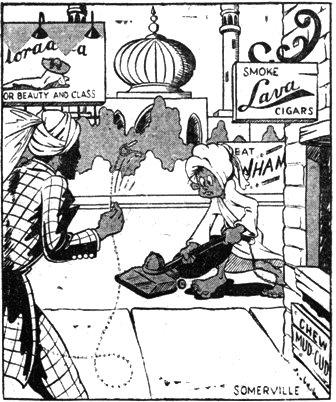
|

|

VOL. III NO. 7 REG NO. L5015 DELHI, THURSDAY OCTOBER 26, 1944.
ADVANCED BASE, 14TH AIR FORCE, OCT. 16 (Delayed) - A single seasweeping B-24 blew up a heavy cruiser and sank a destroyer in a 55-minute low-level attack early today on a six-ship Japanese naval formation moving towards Formosa.
The bomber probably put a crimp in the Japanese naval reinforcement of that island stronghold which has recently taken a blasting American attack. At any rate, the sinkings rank as one of the most notable one-plane achievements of any air force - all the more notable at a time when the 14th is fighting to retain a narrowed foothold in southeast China.
A fiery blast jackknifed the cruiser and filled the air with shattered armorplate and other debris. Evidently the bombs touched off a magazine. The explosion thrust the silvery tail of the Liberator upward and nearly plunged the plane crew of 11 into the China Sea from a perilously low bombing altitude - a few hundred feet.
ALL THE STRENGTH
It took all the strength of command pilot Maj. H. S. (Stump) Carswell, Jr., and pilot Capt. Donald N. Armstrong to pull the B-24 out of a dive. Four times the plane ran into converging ack-ack and pom-pom fire from the formation which originally consisted of four destroyers and two cruisers, but got back to this base low on gas, but undamaged.
The cruiser, a three-stacker, is tagged for one of the Natori or Kuma class. The destroyer is of the Terutsuhi class. They were knocked out with the expenditure of 12 bombs, nine for the destroyer and three for the cruiser. There were four bombing runs in all.
The B-24, especially equipped for night-time seasearching, took off from this base yesterday afternoon and roved the lanes of the South China Sea for eight hours before spotting the ships off Swatow 16 minutes after midnight. They headed eastward toward Takao.
One of the ships was immediately identified as a destroyer. T/Sgt. Kenneth A. Barber translated Carswell's message to the base that they had sighted a destroyer and five "unknowns."
"I thought at the time that probably the destroyer was escorting merchant ships," Carswell said, "I soon found out what we were up against."
Working with special observer S/Sgt. Vincent P. Zeyak, the bombardier, Lt. Nolan W. Klepinger, lined up the plane lengthwise on the target. He and the rest of the regular crew have been credited with one probable, one confirmed and one damaged in attacks on merchant ships already this month.
"Didn't want any 'probable' this time," Klepinger said.
CIRCLE QUARRY
The plane had circled the quarry 25 minutes while the Liberator men calculated the best angle of attack. The night was moonless and the sea, except for the darkened ships, was a black void. The enemy held fire as Zeyak called out the narrowing distance to the target over the intercommunication for Klepinger - "Two miles, one mile." Then came Klepinger's "Bombs away!" As the other warships saw which of them was being attacked the five opened fire. The destroyer's guns were still not firing for concealment's sake.
Klepinger scored two direct hits and one near miss on the first run. At the same time the young, eager eyes staring out of the Liberator spotted a nearby cruiser. The hits stopped the destroyer. It started blinking signal lights at the cruiser which pulled away from the destroyer. Another hit was scored on the smaller warship on the second run.
|
By this time the formation had been pretty well cased. On the third run the Liberator made for the cruiser through a gauntlet of gunflashes.
RIGHT ON
"We were right on her," Carswell said, "I told Klepinger to let her have the last six bombs. He was pretty cool. Why spend six when three can do the trick, he told me. Seeing the results he got, I got no kick coming."
Carswell said, "There was a big explosion and we were right over it. We could see stuff exploding in front of us and behind us. It was like an ammunition dump going off in every direction. At the same time the plane tilted nose-down."
Armstrong said, "I thought we had our tail blown off. We pulled back as hard as we could. The plane leveled out and started climbing. Then tailgunner Leonard called out through the intercommunication, 'that cruiser's blown up all over the sky.' We felt better."
HELD FIRE
Tailgunner is S/Sgt. Reginald R. Leonard. He and S/Sgts. John P. Nolan and Fernay R. Kunkel, in the nose and top turrets respectively, withheld the Liberator's own fire throughout the attack for concealment. The particular duty of the gunners was to guard against interceptors while crossing and recrossing the enemy-held coastal regions.
The cruiser folded in the middle and sank in three or four minutes. The jubilant bomber crew then tensed itself for the final run on the destroyer. Klepinger laid in three near misses, but the destroyer was already sinking. Everyone sweated out the homeward journey, especially the engineer, T/Sgt. Emory G. Lusk. On the final run, everything was thrown out but saki bottles at the remaining warships, for it was not known how badly the Liberator might have been shot up. But the four big engines functioned perfectly.
"The navigator did a beautiful job," Carswell said, "If we got lost, we would have been cooked. When we landed we had about an hour's gas left."
The navigator is Lt. Alfred T. Withiam. He and other crewmen who recovered their appetites homeward bound broke out "K" rations and postmortemed the whole operation over pork and egg-yolk and American cheese spread on "dob biscuits."
It was still dark when they landed and hit their sacks. later in the day they examined the plane and found not even a scratch.
SAGA OF 490th BOMB SQUADRON, 10th A.F.
HQ., TENTH AIR FORCE, INDIA - The presence in the China-Burma-India Theater of the 490th Bombardment squadron (M) of the 10th USAAF, has been officially released, it is announced this week. Designated the "Skull and Wings" Squadron, this B-25 medium bomber unit is better known as the "Burma Bridge Busters." Since Jan. 1, 1944, it has knocked out more than 100 key bridges in enemy-occupied Burma. This score was made by a bombing technique developed within the squadron - a technique which was a departure from methods used previously.
The squadron - as such - has never been in the United States. It was activated on Sept. 18, 1942, by the 10th USAAF at Karachi, India. In late December it moved forward and flew its first mission against the Japs on Feb. 18, 1943. The ferry slips at Sagaing on the Irrawaddy just south of Mandalay were leveled.
For the next few months, it carried out routine missions against the enemy, blasting railway junctions, river shipping, supply dumps and troop concentrations. In May, 1943, Lt. Col. (then Major) Robert D. McCarten of Fargo, N.D., became commanding officer and it was in his regime that the operations occurred which started its brilliant record. Holder of the Air Medal and DFC, each with an Oak Leaf Cluster, the Silver Star and Purple Heart, Col. McCarten encouraged the experiments carried on by his men which proved so highly successful.
The first of these concerned operations during the monsoon season which holds India and Burma in its grip from May to October. Rain squalls, near-solid overcasts, limited visibility and thunderstorms made even ordinary flight hazardous over the mountains and jungles of this region. Effective combat operations were believed impossible.
Yet, during both the 1943 and 1944 monsoons, the 490th flew a regular schedule of bombing missions - with an average of two every three days - without a single cancellation. Incidentally, during the first monsoon - in August, 1943 - Col. McCarten and his crew were shot down over the Burma jungles, but made their way back without loss or serious injury.
In November, the squadron, on a significant mission, had a crack at a bridge using accepted tactics. Along with two other medium squadrons and a group of B-24's, it attacked the Myittha Bridge, an important railway bridge south of Mandalay. The bridge approaches and the territory immediately surrounding it were blanketed by bomb bursts, but the bridge remained standing comparatively undamaged.
Members of the squadron, shortly thereafter, began low-level bombing of bridges. Here, again, with bullseye accuracy, it was expending bomb loads without any great success. Known then by the popular name of "skip-bombing," it proved to be too apt a designation. The bombs skipped under and over bridges - sometimes endangering the aircraft - before they exploded.
With the encouragement of their commanding officer, two pilots began devising means to take the "skip" out of low-level bombing. They were Maj. Robert A. Erdin and Capt. Harry S. Sutphen. Maj. Erdin is present squadron commander. Capt. Sutphen was later reported as missing in action. Their suggestions were tried out by themselves and squadron mates until the successful technique was discovered.
New Year's Day, 1944, saw the payoff. The Mu River Bridge in Central Burma, one of the most important
|
The squadron probably received its greatest satisfaction from the destruction of the Myittha Bridge mentioned in the preceding paragraphs. One aircraft, piloted by Capt. Angelo J. Boutselis, completely destroyed it using only two 1,000-ib. bombs. This occurred on Jan. 15th - shortly after the new technique was proven practicable.
During the North Burma campaign and also those in the Arakan and Imphal regions, the 490th gave close support to ground troops by pin-point bombing of Jap positions. In one instance in a dusk attack on an enemy camp, the squadron killed more that 1,150 Japs and received a commendation from Gen. W. J. Slim of the 14th Army. Congratulatory messages were also received from Maj. Gen. Howard C. Davidson, Commanding General, 10th USAAF; Air Vice Marshal Sir John Baldwin, Air Commander, 3rd Tactical Air Force, Eastern Air Command, and Air Marshal Sir Richard Peirse, Air Commander, SEAC, for this feat.
Because of the speed, maneuverability and defensive power of its aircraft, the 490th has had comparatively few brushes with enemy interceptors. In these encounters, it has to its credit 10 Jap fighters destroyed, 11 probably destroyed and 10 damaged, for a loss of four of its own.
Personnel of the squadron have won 656 decorations for their excellent work. A breakdown shows 320 Air Medals, 56 Oak Leaf Clusters to the Air Medal, 238 awards of the DFC, six Oak Leaf Clusters to the DFC, 27 Purple Hearts, one Oak Leaf Cluster to the Purple Heart, four Silver Stars, one Soldiers Medal and two awards of the Legion of Merit make up this total.
|
HAM AND EGGS By SGT. SMITH DAWLESS Poet Laureate of C.B.I. Now Edward was a headstrong lad, Male warblers made him cranky, He swore he'd humble and deface Our honey-throated Frankie. Pitching true from where he sat, This gleeful 5 foot 10 brute, Draped the startled Voice's puss With luscious new-laid hen fruit. The Bobby Sockers went berserk And screamed it was inhuman To decorate their Send-Me boy With egg-yolk and albumen. The coppers hustled Edward out Before they started shooting. Tho "not amused" Frank volunteered To do no prosecuting. What rupees plenty we'd have paid To see that little opera. When we get home be sure we'll ask For Omelet Sinatra! |
WE'LL GET SPAM
Come Thanksgiving Day, Nov. 23, the turkey will be on the table in CBI, complete with all the customary trimmings of cranberry sauce, mince-meat and dressing.
Queried this week the Theater QM Substinence section said they have arranged through the British to obtain from the Royal Indian Army Service Corps considerable supplies of fresh turkey, from birds raised by independent breeders on Indian poultry farms, most of them in the Punjab.
Local supplies will not suffice, however, and the difference will be made up with Stateside, deboned canned turkey, which is regarded by many G.I.'s as good as or better than the local product. Issue will be on the basis of one pound of canned bird per man said the QM.
The War Food Administration embargoed turkey sales to private buyers in the U.S. until Army requirements of 35,000,000 pounds for the holiday season had been met, while a million pounds of mince-meat and one third of the nation's cranberry crop were similarly earmarked.
Shortage of refrigerated ships restricts the supply of fresh meat from the U.S. although a small quantity of frozen beef has come out by air in recent months. Indian sources of meat are operating at peak capacity, says Lt. Col. Carl Nordstrom, QM Substinence officer, but a projected expansion of refrigerated shipping facilities, plus the construction of proper storage warehouses for perishables in the Theater, will soon make possible an increase in the amount of Stateside meat available to CBI troops.
|
Melvyn Douglas, ex-Hollywood leading man who is now Theater Entertainment officer with SOS Special Services office, recently had his new Major's leaves pinned on by Maj. Gen. W. E. R. Covell at New Delhi.
Since his arrival in CBI a year ago, the suave, sandy-haired gent who used to get into some neat situation before the camera with Joan Crawford and Greta Garbo, has logged a respectable travel mileage looking for G.I. talent. CBI policy, based on a Douglas-conducted survey, is to find entertainment for the troops among the ranks, augmenting soldier shows with USO units.
To accomplish this, Douglas has set up at Calcutta an "entertainment production unit," unique among overseas theaters, where promising G.I. shows organized in various units throughout CBI are polished up for Theater tours. A staff of show business experts now in khaki - dance and music directors, scenery and costume specialists - work over those aspiring vaudevillians who have shown talent and can be spared from duty by their CO's long enough to complete their tour as scheduled.
Says Maj. Paul Zimmerman of the SOS Special Services office, "Douglas has done a terrific job. He left Hollywood at the peak of his movie career to join the Army, and sacrificed a considerable income from acting contracts to do so."
|
ATC BASE, APO 466, INDIA - There was a time when Sunday evenings around this place were duller than a WCTU picnic, but that was before the Special Service office started digging into people's pasts and unearthed a wealth of "local talent."
Yes, Sunday evenings are lively now. In fact Lt. Billy O. Phillips, Special Service Officer, and S/Sgt. Raymond Gray, former Hollywood actor and writer and now entertainment director at this India China Division ATC base, have gone so far as to recruit Nagas from the surrounding hills to sing hymns in their native tongue for the edification of G.I.'s.
Getting down to cases, the talent scouts have discovered the following star performers who have contributed to frequent Sunday stage shows:
A vocal quintet comprising Pfc. Charles A. Brown, Pfc. George E. Anderson, Pvt. Nathaniel C. Barlow, Pvt. Henry Clay, and Pvt. John Crutcher, whose song arranging is done by Pfc. John Gillespie.
S/Sgt. Ray M. Paralta, a tap dancer; Pvt. Ernest C. Brundage, vocalist; Pfc. Arthur George, a cowboy singer a la Gene Autry; Pvt. Andrew Duggan, impersonator; Pfc. William N. Finkelstein, and Cpl. Lawrence R. Shiner, comedians, complete the cast.
Rat Killer's V-2 Weapon Sling-Shot
CHINA - Pvt. Jimmy Tucker was no great shakes on the rifle range but he qualifies as an expert with the men of this outfit and it means more to them than the kind of shooting Uncle Sugar hangs medals on guys for.
His weapon is the lowly sling-shot and to attest his prowess he has (or you take 'em) the pelts of dozens of rats that once infested our barracks.
The rats had long since become a pest and serious thoughts of carbines had occupied the minds of some of the men. Had not Tucker solved the situation the barracks roof might have soon assumed a cheesy look.
Tucker likes to go hunting at night, with his flashlight fixed on his cap. He explains that at night the men are asleep and don't move around in the path of his projectiles. The men appreciate this thoughtfulness too, especially since Tucker started using slugs from carbine ball ammunition in his sling-shot.
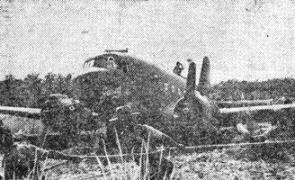 The ASC reclamation crew, aided by British troops, are shown here busy at the hazardous task of getting C-47
"Janey" in proper position for necessary repairs. "Janey" had landed in this enemy-held territory, bogged down in
a bomb crater.
The ASC reclamation crew, aided by British troops, are shown here busy at the hazardous task of getting C-47
"Janey" in proper position for necessary repairs. "Janey" had landed in this enemy-held territory, bogged down in
a bomb crater.
|
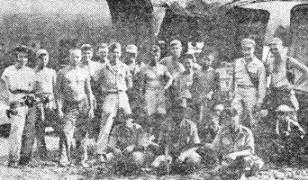 "Burma Peacock" salvage boys shown in this photo are: W/O Herbert Carr, Capt. Charles A. Herzog, S/Sgt. Don Hall,
M/Sgt. Irving C. Sallette, Pfc. Ernest Luzier, Sgts. Roland Wechsler and Clifford Baumgart.
"Burma Peacock" salvage boys shown in this photo are: W/O Herbert Carr, Capt. Charles A. Herzog, S/Sgt. Don Hall,
M/Sgt. Irving C. Sallette, Pfc. Ernest Luzier, Sgts. Roland Wechsler and Clifford Baumgart.
|
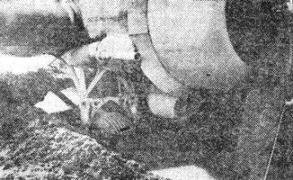 After many hours of digging, the ASC salvagers finally got "Janey's" wheels in position to be rolled out of the
crater. besides the threat of Japs on all sides, the crew had to contend with rice paddy water shown here.
After many hours of digging, the ASC salvagers finally got "Janey's" wheels in position to be rolled out of the
crater. besides the threat of Japs on all sides, the crew had to contend with rice paddy water shown here.
|
ASC PLANE SALVAGER WORKS IN NIP LINES
ASC BASE, BURMA - "Bring 'Em Back Alive" they're beginning to call Chief W.O. Herbert W. Carr of this Air Service Group's reclamation detachment. Carr makes a specialty of going into jungle or rice paddies or the mountain country in search of crashed airplanes; of bringing out those ships whole or in "complete pieces;" and recently he climaxed all his previous Frank-Buck exploits.
He took a crew behind Jap lines, and brought back a C-47 which had crashed into a crater hole - the location being behind the known perimeter of the Jap knees.
MERE CHANCE
According to the commander of Carr's outfit, the "Burma Peacock's," the opportunity to attempt reclamation came by merest chance, when a liaison airplane reported having seen a mired C-47 on the ground.
Carr's crew consisted of M/Sgt. Irving C. Sallette, assistant line chief; and four helpers, Sgt. Don Hall, Roland Wechsler, Clifford Baumgart, Jack Tuton, and Pfc. Ernest Luzier.
The party was flown into the area by Capt. Charles A. Herzog, on a UC-64 light cargo ship. Equipment consisted of two five-gallon cans of drinking water, K-rations, 180 pounds of rice, 10 pounds of tea, and 20 pounds of sugar, in addition to kits of tools, a chain hoist, axe and other items for the job. The rice, tea and sugar were for such coolie helpers as they hoped to impress from neighboring jungle settlements.
NEXT SIX DAYS
For the next six days the men fumed and tussled in the hot sun; gradually jacked up and pulled the C-47 from the bottom of a bomb crater; repaired its gear and got its engines going.
At first, no coolies appeared, so a runner was dispatched to try to rent some elephants, when and if the pachyderms could be located. One elephant almost arrived on the job, but unfortunately Dumbo put his foot into a booby trap and plunged, screaming with hurt, through the grass, his body stinging with shrapnel. In a day, the coolies, ever sensing the need for their well-paid services, began to show up.
The extra workmen were sorely needed, according to Carr, who was forced to call off work on the first all-day shift, due to excessive heat and lack of salt to counteract the drain of energy. Eventually, the C-47 was removed from the crater by piece-meal hauling along a fresh-cut incline up the mud slopes.
PILOT ARRIVES
When the airplane was on dry land again, engines were turned up, and the craft soon was lined up for take-off. However, an overnight wait came into the picture, the ship being absent one pilot. In the morning Combat Cargo Command dropped in with a pilot; the rejuvenated C-47 took off like a breeze, and another craft had been brought back "alive" under the ministrations of "Frank Buck" Carr.
No trouble was caused by Japs during the stay of the mechani-commandos. The Japs had learned from previous experience that Chindits and Chinese-American forces do not allow Nippons to intrude on workers without one hell of a fight.
10th Air Force Awards Medals For Brave Acts
HQS., 10TH AIR FORCE, INDIA - Thirteen members of the 10th Air Force, ranging from captain to private, were recently awarded Soldier's Medals in recognition of their daring acts of bravery, which reflect "credit to the military forces of the U.S."
The citations revealed feats of heroism varying from rescue of personnel from burning planes to saving the life of a drowning man. The deeds of these men make a long list and all most worthy of commendation.
Cpl. Souldon W. Richardson, for example, ran into the nose of a crashed and burning plane and rescued one of the crew members while 50 caliber ammunition exploded all around him. For this he received the First Oak Leaf Cluster, having been awarded the Soldier's Medal earlier for a similar deed.
Others who received awards:
Capt. William DeVlaming; Lt. James L. Nemecek, Jr.; S/Sgts. Vivian T. Davis, Raymond T. White and Michael F. Neeman; Sgt. Russell W. Curtis, Arthur L. Filbeck and Boyd Headrick; Cpls. Emanuel A. Morzinsky and Joseph Andrade; and Pvts. Francis U. Burnham, Jr., and Richard L. Williams.
|
OUR MOTTO: “WE CARRY ANYTHING” The crew of the Troop Carrier Command plane searched for the obscure British landing field in Burma, located it among the jungled panorama beneath them and touched down to carry out another mission. While they waited for instructions, the crew held a hangar session, recounting some of the dangerous jobs they had carried out - sneaking through mountain passes to evade Zeros, fighting instrument weather, dodging enemy ground fire on dropping missions, landing on corduroy fields newly hacked out of the jungle. A British officer with concern advertised on his face, strode up to the plane and asked to speak to the pilot. Off to one side, the two held a long conversation, with a great deal of gesticulation. The pilot returned and announced bitterly: "This is the payoff. Know what we've been assigned to do? Evacuate war-weary mules." BAKSHEESH NAY! LEDO ROAD - A beggar-wallah came up to me with a note. I tried to decipher it. Seeing my difficulty, the blind beggar said, "Sahib, spectacles," pointing to my G.I. glasses. He got no baksheesh. - By Cpl. Irving Marder. |
CARRIED GAS TO CHINA
HQ., 10TH AIR FORCE IN INDIA - With the release of a message by Headquarters 10th Air Force from Maj. Gen. Claire Chennault, Commanding General, 14th USAAF, to Colonel Aubrey K. Dodson, Commanding Officer of the Seventh Bombardment Group, a closely guarded secret operation has been revealed. For the past few months, B-24's of the Seventh have been delivering high octane gasoline to the 14th Air Force on the other side of The Hump over the world's toughest flying route.
In his message to Dodson, Chennault said:
"The Japs will again receive the same staggering blows from the Seventh Bombardment Group now that it has resumed tactical operations that it delivered to the enemy in Burma for so long a period of time. Our heartfelt appreciation is extended to all of you who were responsible for the wonderful job in delivering all of this gasoline to China. By doing so, you have made it possible for our units to harass and hit the enemy where otherwise it would not have been possible. The Seventh has a proud record and a confirmation of this fine spirit and determination is bound to be reflected in your operations as you resume normal combat status. Good luck to you and all members of your command in accomplishing your missions."
The pioneer unit of the 10th Air Force, the Seventh holds the record for continuous action by a heavy bombardment group against the enemy in World War II. With an inauspicious beginning - it was planes of the Seventh which circled Hawaii helplessly without ammunition during the attack on Pearl Harbor following a flight from the United States - it has compiled a highly satisfactory score against the Japs. The majority of the combat crews of the famous 19th Bombardment Group were members of the Seventh. They were hastily incorporated into the 19th in the Philippines and fought through Java to Australia in the vital delaying action that saved that continent. Those that were left came to India and joined the 10th USAAF in March, 1942. For their work in Java, they received a Presidential citation.
In more than two years operation against enemy-held Burma and Thailand, it helped to institute and maintain a virtual blockade of those countries. The methodical pounding of Jap supply lines in this period was a major factor in the recent victorious Allied ground campaign in Burma.
When the situation in China became critical with the Jap offensive beginning, the 14th USAAF needed all the gasoline it could get to make the enemy advance as costly as possible. The Seventh - who helped out the Ninth USAAF in June, 1942, when Rommel was knocking at the gates of Cairo, turned its planes into aerial tankers to aid the 14th. Gen. Chennault's message attests the excellent job it did.
It was not an easy job, in fact, the Seventh suffered losses comparable with the toughest bombing mission. Its route lay over the heart of enemy-held Burma. Its cargo was potentially more dangerous that any high explosive. It had to fly through monsoon weather over the highest mountains in the world. The jungles of Burma made a forced landing or bail out suicidal. The crews were short-handed to save precious weight and were not so strong defensively as a result against enemy fighters.
Also, with equal hazards, the crews were denied the satisfaction of directly attacking Jap positions.
2,100 LETTERS SINCE JAN. - WOW!
We should have known better.
In the Oct. 12 issue, the Roundup printed the claim of Pfc. Ward Cramer, APO 885, to be the "letter-writingest man in CBI," having penned 860 messages since Jan. 1.
Cramer's boast ended with the query, "Can you beat it?"
This week Pvt. Paul R. Edwards, from up at APO 218, writes in that he can. Modestly saying that he doesn't "want to brag," Edwards declares:
"With my 24 girl friends (ahem!) and relatives and friends, I can truthfully say I write at least 50 letters a week, and have done so since Jan. 1." And for proof, he suggests: "Just ask my censor."
(Ed. Note - Roundup staffers took off their shoes and did a little summing up. Hours later, we figured that Edwards has written 2,100 letters since January. We're writing his censor.)
EXPEDITERS MOVE HUMP SUPPLIES
HQ., ASC AREA COMMAND, ASSAM - Here among the waist-high tea gardens of Assam there is a group of non-flyers who could tell plenty of facts about the air supply line to China, subject of a recent press conference statement by President Roosevelt.
These men are in the "movements sector" of the Plans and Operations Division of this ASC unit and they work only on Hump operations, acting as liaison between ATC and depots which issue the material.
Maj. Louis R. Fimian, who formerly handled traffic over the North Atlantic for ATC, heads the expediters. His right hand man is W/O Donald Loftus, who is finishing his 30th month in the CBI.
The enlisted men's team is composed of M/Sgt. Robert L. Gregory, Sgts. Arthur C. Hanson and Lawrence J. Ray; Cpl. Elmo A. Perry; Pfc. Sherman A. Klein and Pvt. Seymour W. Levine. Team coach is Lt. Paul Davidson.
Fimian was a one man department up to a year ago, flying to all parts of the theater on speed-up matters. He had to take seven weeks off for a hospital stay after a plane crash that killed eight of the 10 occupants.
Then he started his organization. It moves supplies in a steady stream. All items are marked and packed, so divided that cargo space is best utilized. Records of types and amounts are kept. Passengers and freight are screened.
The expediters have one motto, "Get the most cargo in the least space."
|
ON THE ROAD TO MANDALAY - Capt. Paul J. Bamberger is a dark-eyed, soft-spoken gentleman from Virginia - Alexandria, Va. - with a talent for under-statements.
Standing on the banks of the monsoon-swollen Loylaw River 15 miles south of Mogaung, Capt. Bamberger watched his men laboring on an improvised skid rig pile-driver and said, "We're having a bit of trouble on this bridge."
The captain's "bit of trouble," I learned, was the reconstruction of a 400-foot railway bridge on the Mogaung-Mandalay railroad. During the offensive south of Mogaung, American airmen had leveled the bridge and tied up Jap rail traffic to the south.
The captain's boys - one company of a hard-bitten group of Engineer veterans who have been pushing the Ledo Road forward from the hills of Assam into the jungles of Burma for the last 20 months - were put to work repairing bombed-out bridges on the Myitkyina-Mogaung rail line during the battle for Myitkyina. Finishing that job, they were assigned the task of rebuilding railway bridges on the heels of the British 36th Division's march.
"This job has been a tough nut to crack," Capt. Bamberger explained, "because the Air Force did such a complete job of demolition, we have to practically rebuild the complete structure."
Pointing to the pile-driver, the captain told how lengths of four-inch pipe had been brought down the Mogaung River by barge from Warazup to the Loylaw River and down the Loylaw to the bombed -out bridge - a distance of 80 miles.
Pilings proved to be another headache. Good timber was not available, and all steel that was floated downstream by barge, plus all that was salvaged from the bridge, had to be utilized to replace missing girders and supports. The problem was solved, Bamberger declared as we watched T/4 Payne S. Snow, of Centerville, Tex., at work with a welding torch, by joining steel rails from the railroad's abandoned sidings.
Over at the pile-driver, Lt. D. M. Landry kicked gobs of heavy monsoon mud off his shoes and said he'd sure like to be back in Monroe, La., where he could forget the jungle and rains and railroad bridges and Spam. And S/Sgt. Adam Kuzmich said that the frozen wasteland of Northern Canada, where the outfit spent months building Army installations before coming to CBI, was Heaven compared to the "stinking green jungles we've been pushing through for so many months now."
Just then the pile-driver began to cough and sputter ominously and Landry and Kuzmich forgot the mud and the rain and the Spam and plunged knee-deep into the murky waters of the river to check on the equipment. A few minutes later the pile-driver was operating smoothly once more.
"That's how it is," Bamberger chuckled. "We all hate this damned country and we gripe plenty. But we get the job done." The captain admitted that his boys had been in some "warm" spots.
"Once, at Taipha Ga," he said, "we built an air strip under enemy artillery and sniper fire. The boys worked on armor-plated cats, and we'd withdraw from the field when the Japs started an artillery barrage, then go back to work when the smoke cleared. Some of the boys got Purple Hearts for that job."
The captain and I found S/Sgt. Herbert L. Lundblad, construction foreman, and T/Sgt. Robert G. Powell, draftsman, huddled in a dinky boxcar, out of the rain, studying blueprints of the bridge.
As Bamberger and I climbed on the jeep train going into Mogaung, the angry black clouds overhead cut loose with a torrential monsoon downpour. Even the low green hills a few hundred yards away were veiled by curtains of rain. And the captain casually remarked: "It gets kinda wet here at times."
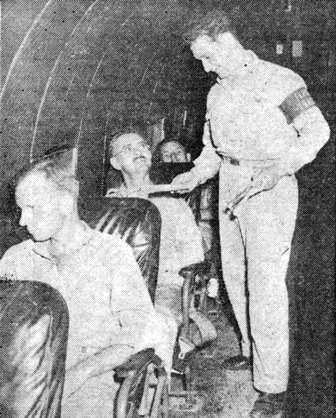 AIR TRANSPORT COMMAND BASE, INDIA - Pvt. Adam Achmitz passes out reading material on one of the new ATC planes
equipped with reclining, padded chairs. It ain't like the old days.
AIR TRANSPORT COMMAND BASE, INDIA - Pvt. Adam Achmitz passes out reading material on one of the new ATC planes
equipped with reclining, padded chairs. It ain't like the old days.
 At Agra, by the river Jumna's banks, A marble tomb, by master hands made fair, Immortal to the memory of love, Recalls her beauty who lies buried there. A central dome and slender minarets Arise above a queen's enchanted sleep To lift unearthly splendor to the moon And cast a spell long centuries may keep. Mumtaz Mahal, beloved of Shah Jehan, Once heard him vow he would not wed again; And he who mourned her passing from the world Raised this rare monument to show all men. This mausoleum to remembrance where The travelers in wonderment invade Is a prince's marble testament of love, With jaspers, bloodstones and agates rich-inlaid. - Sgt. Elwood Jones. MONSOON UNVEILS UNKNOWN ENEMY MYITKYINA - This famous "hot strip" of the Burma air war has its strictly unofficial "tomb of the unknown Japanese soldier," the monsoon's last flash downpour recently disclosed. When the waters came - a Jap shin bone was exposed to view in the setting. When the ASC personnel stationed nearby had satisfied themselves that it was a little Jap soldier buried there, they covered up the bones and let the enemy keep silent guard to Nippon's broken power in North Burma. HARDIN RECEIVES LARGE GONG WASHINGTON - (ANS) - Brig. Gen. Thomas O. Hardin, until recently commander of the India-China Division of the Air Transport Command, has been awarded the Distinguished Service Medal for development of "the aerial lifeline to China." Gen. Hardin has returned to the U.S. to take an unannounced assignment. LEGION OF MERIT TO SEAGRAVE Lt. Col. Gordon S. Seagrave, famed "Burma Surgeon" who accompanied Gen. Joseph W. Stilwell in his retreat from Burma in 1942, was awarded the Legion of Merit this week for his "exceptionally meritorious service" during the period of March, 1943, to September, 1944. |
Plush Ousting Buckets
ATC BASE, INDIA - The old bucket seat, symbol of rugged warfare in CBI, is giving way to padded reclining models which face forward, and a new flight clerk service has been added to many of the C-46's and C-47's flying the routes which stretch from Karachi to China.
Flight clerks, graduates of a special school at Hamilton Field, Calif., not only handle paper records for passengers and cargo and see that things and people are unloaded at the proper stations, but also look out for the comfort and happiness of the customers. Magazines, books, playing cards, drinking water and in some cases hot coffee are their stock in trade.
Airline hostesses have nothing on them - well, not much. Or as one Hump-happy veteran, rotation-Statesward bound, put it as he enjoyed his first upholstered deluxe ride: "The only way they could beat this would be to make those clerks WAC's."
Bronze Stars For AACS Men
MYITKYINA - For "meritorious service" during the battle of Myitkyina, five members of the Army Airways Communications System detachment at the airfield have been awarded Bronze Star Medals, Lt. Col. Jess R. Guthrie, commanding officer of the AACS for the Burma-Assam-China area, has announced.
The men, T/Sgt. Charles Burke, T/Sgt. Glenn Kittleson, Sgt. Leonard Jones, Jr., Sgt. Victor Lundy and Cpl. Irwin S. Schwimmer are control tower operators. Their jobs often kept them in the tower, one of the most exposed spots on the field, while the Japs were lobbing shells across it from positions in the town, and while Jap planes were directly over it.
The original code name for the Myitkyina tower was "fox hole," but actually it was located in the cockpit of a cracked-up transport set back from the center of the runway. Shells fell all around it and one bomb burst lifted it completely from the ground.
The present tower was built with lumber from a dismantled Jap command post tower on the Irrawaddy River, and boasts such unusual appurtenances as reflectors made of beer cans, and insulators made of G.I. rubber heels. "There wasn't much here," the boys tell you, "and we couldn't be choosy."
HAVE AMERICAN GALS
IN CBI ANY FUTURE?
By JACK GUINN United Press War Correspondent
SOMEWHERE IN INDIA - Preferred conversation among the American G.I.'s at Army establishments here concerns the shortage of American women; how the American women who are here spend their time, and sundry post-war question relating to women and related subjects.
There are some American women, engaged in one thing or another, operating around the American forces in India. It would take a month of research to account for them all.
Among the American women are nurses, but nurses wear bars, and G.I.'s generally don't go for bars, despite that to which they're attached. There are also Red Cross girls and U.S. civilian employees of various organizations.
MAIN CONCERN
So the main concern of the American G.I. is the talent reasonably at hand; civilian employees and Red Cross girls.
The G.I. like anybody else, gets pretty lonesome in this semi-civilization, for idle chit-chat and maybe a cup of coffee with a female from home. She may be homely as sin, but she might say "hey, bud," and the very sight of her looks like pie a la mode and Saturday night jitterbug contests to the tired eyes of homesick Americans.
But the trouble is, a G.I. likes his innocent chit-chat in private and the only way to arrange this is to talk the wench into a date, cart her off some place in a lonely taxi, which, under prevailing conditions, is no small financial chore for a guy on the little side of the Government payroll.
NOT SO SIMPLE
But even that is not as simple as it sounds. It would be safe to say that if a G.I.'s request for a date were granted it would be so far in the future that by the time she was ready to go out with him he'd be a psychopathetic case from chalking off the days on his fingers and toes.
Besides this, some G.I.'s have complained that some of these chickens from the home yard have mistaken this complicated booking arrangement for the well-deserved popularity and have acquired a certain snootiness. Some even say that a few girls are rank-conscious and prefer being with officers, most of whom are prettier with their brass and such, and most of whom are better heeled financially.
It is a general G.I. contention that certain cases of this self-admiration on the part of the girls does not necessarily stem from looking in mirrors.
This is the state of affairs which brings up the post-war question: what are these girls going to do when the war ends and the rush is over? Will the girl who was queen of the ball in India with chicken colonels and the like trotting at her heels, even get to the front door of the ball when she gets home?
Most G.I.'s generally think not, and they're sympathetic.
NO SOLUTION
They don't expect too much from anybody, things being what they are, and they are aware of the out-of-balance ratio out here between American men and American women.
And they don't offer any solutions. In the first place, the best solution would be to import more women, which is unreasonable and unlikely. A possible solution would be for the girls to set up a system of rotation - and include G.I.'s along with the brass - which is also unlikely.
In the second place, the whole thing makes such good G.I. conversation.
Japanese Drives Halted In China
Roundup Staff Article
Aided by a week of concentrated ground support attacks by planes of the 14th Air Force, the Chinese armies in the bend of the West River, 160 miles south of Kweilin, halted the Japanese drive in the Kweiping area aimed at Liuchow to the west. The Chinese High Command said their troops had also driven back the Japs facing Kweilin in a six-mile counterthrust.
Low-flying aircraft in the river bend area repeatedly bombed the Jap-held towns of Kweiping, Kwangkiang, Pingnam and Menghu, hitting paneled targets indicated by ground forces engaged in the heavy fighting. On one mission, B-25's, P-51's and P-40's together attacked Samshui on the river, scoring 95 percent hits in the dock areas with fires and heavy damage. One of several intercepting Jap fighters was shot down, plus one probable, one damaged, and one destroyed aground.
SWEEP RIVER
Fourteenth fighters continued to sweep the river from Wuchow to Tanchuk, destroying or damaging at least 34 river steamers, in addition to sampans, barges and launches. Japanese troop concentrations were severely strafed, killing hundreds.
Southwest of Hong Kong on the night of Oct. 18, a B-24 sank a 336-foot Jap destroyer of the Mutsuki class, securing direct bomb hits followed by secondary explosions.
Other B-24's bombed the Kowloon wharves at Hong Kong Oct. 17, as late reports from the previous day's raid showed that an even heavier blow had been struck at Jap shipping than was first believed. Eight vessels totaling more than 40,000 tons were sunk, seven more were damaged and five probably damaged. Dive-bombing fighters were credited with two ships sunk, while B-25's got five. This figure did not include the Nip cruiser and destroyer sunk off Formosa by a single night-ranging B-24.
TWO SHOT DOWN
Two of eight Jap fighters intercepting a mission against supply depots near Canton's Tien Ho airdrome were shot down, and two others damaged. A Jap plane was destroyed by strafing in a revetment at Tanchuk airfield, recently taken by the enemy from the 14th.
P-38's on the Salween River front successfully bombed several bridges and attacked Jap positions at Cehang and Mangshih in support of Chinese ground forces, while other 14th planes busted five locomotives and two river vessels in French Indo-China.
Adverse weather in the Kweilin area hampered air operations throughout much of the week.
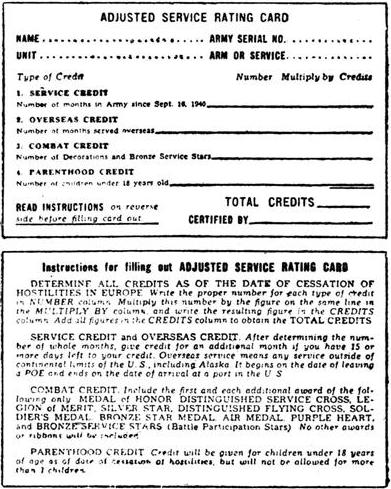
|
|
ON MINE
Meet Peter S. Hopkins, Capt., Engineers, U.S. Army. Age 22, tall, red-headed, and hailing from Boston, Mass. Dropped out of the '44 class at MIT to join the Army April 7, 1942.
Sent to CBI he has been on active duty with the Chinese Army as a member of Brig. Gen. Frank (Pinky) Dorn's Y-Forces since April, 1943.
Outstanding achievement: Assisting in planting a tunneled mine under the Jap garrison at Sungshan in the Salween operation. The story in short . . . The Chinese had bravely but vainly tried to charge up the mountain against the entrenched Japs . . Hopkins was assigned as part of a Y-Force group to plan with Chinese Engineers how to blast the Japs from their dominant positions . . The Engineers dug for days, blew the Japs off the heights of the mountain . . The Chinese occupied the craters, stormed the Nip positions and took Sungshan.
In two years of occupation the Japs had heavily fortified Sungshan . . Hidden guns dominated excellent fields of fire . . The Nip position was almost impregnable . . But when Hopkins and the Y-Forces and the Chinese mined under the Nips their positions ceased to be impregnable and they literally flew up to join their ancestors in Hirohito heaven.
FESTING’S FORCES CAPTURE MOHNYIN
Roundup Staff Article
While British troops of Maj. Gen. Francis W. Festing's 36th Division advanced south from Mohnyin and consolidated their positions in this recently occupied village along the railway southwest of Hopin, the Salween Expeditionary Forces wiped out another Jap strongpoint south of Mangshih as the troops of Gen. Joseph W. Stilwell continued their campaign to join up along the new Ledo and old Burma Roads.
The weather still did not permit more than limited activity on either the North Burma or the Salween Front. South of Kazu the Chinese troops continued patrol activity.
The seizure of Mohnyin, 75 miles southwest of Myitkyina, marked the second town of importance taken by the fighting Festing troops. Their first sizeable objective was Hopin and from there they kept advancing along the railway line towards Mandalay until they took Mohnyin early this week.
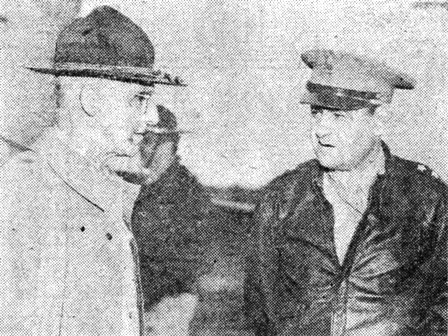 Gen. Joseph W. Stilwell, left, Commanding General of the USAF, CBI, gets together with Maj. Gen. Curtis E.
LeMay, Commanding General of the 20th Bomber Command, whose planes raided Kyushu again Wednesday.
Gen. Joseph W. Stilwell, left, Commanding General of the USAF, CBI, gets together with Maj. Gen. Curtis E.
LeMay, Commanding General of the 20th Bomber Command, whose planes raided Kyushu again Wednesday.
|
BRITISH 14TH TROOPS
TAKE TIDDIM, PUSH ON
Roundup Staff Article
Troops of the 14th Army, with the Fifth Indian Division in the vanguard, are pushing on towards Fort White and the towering 8,871-foot Kennedy Peak defenses, following the capture of Tiddim early in the week.
Further to the south, other elements of the 14th have occupied Falam, headquarters of the Central Chin Hills, and Haka, main township of the Southern Chin Hills, following their evacuation by the Japanese who are attempting to escape towards the east.
The strong Jap defenses at Kennedy Peak and Vital Corner, 13 miles down the road from Tiddim, are heavily fortified. EAC planes are blasting the Nip defenses as the British approach.
In the Arakan, West African troops have crossed the Kaladan River from their hopping off place in the Sangu Valley.
A raid on the Nicobar Islands by the Far Eastern Fleet resulted in the sinking of one medium sized enemy cargo ship and the downing of eight Jap planes. The British lost one bomber and one fighter.
EAC FIGHTERS SWEEP RANGOON AIRFIELDS
Roundup Staff Article
In two mass fighter sweeps of Jap airfields around Rangoon, the largest missions of this type ever flown in Southeast Asia, Eastern Air Command planes this week destroyed 16 enemy planes, probably destroyed two and damaged 15 at Mingaladon, Zayakwin and Hmawoi airdromes.
Beaufighters, Mosquitoes, Thunderbolts and Lightnings roared over the fields in successive waves, strafing Jap planes in revetments or struggling to get off the ground. American and British aircraft of the 10th Air Force and an Air Commando group, the latter seeing their first action since the glider landings in North Burma last Spring, took part in the two raids, which took place two days apart.
The flight involved a roundtrip of more than 850 miles, and many aerial combats took place over the Jap fields, yet only one Allied plane was lost. Strafing attacks lasting for over three hours damaged field installations and buildings.
A command force of Seventh Bomb Group B-24's and RAF Liberators struck at Moulmein, vital seaport at the Salween River mouth, inflicting heavy damage to the jetty area with smoke from fires visible 40 miles distant.
Tenth Air Force B-25's attacked airfields near Mandalay, hitting Onbauk, Meiktila, Thedaw, Shwebo and Nawnghio. They also destroyed or damaged bridges at Hsenwi, Meza and Wuntho. RAF Hurricanes heavily attacked Tiddim just prior to it's fall to 14th Army units, while American P-47's dive-bombed Mohnyin to back up the British 36th Division.
Pilots returning from the Rangoon airfield sweeps had many thrilling stories to tell. Many of them were on their first combat missions.
Lt. Everett Kelly, an Air Commando pilot, got on the tail of a Jap over Mingaladon and fired a long burst as he closed from 300 to 50 yards. "The Jap pulled up sharply," said Kelly, "and I got in another deflection shot as I passed by. I saw his 'chute open; I liked that."
Wing Commander R. J. Walker, Mosquito pilot and Battle of Britain veteran, came home 400 miles on one engine after pieces of a brick revetment he was strafing had knocked out his starboard engine.
Lt. Col. Dave Terry, leading the 10th Air Force P-47's, destroyed one Jap as he was taxiing on the Mingaladon runway, then fought interceptors for half an hour over the field before his ammunition gave out and he was forced to elude them.
Day's high score on the second sweep was credited to Commando pilot, Capt. Olin B. Carter, who knocked off a twin-engine reconnaissance plane and a fighter on the ground and damaged another.
Lt. Marion C. Ball said "I was flying about 15,000 feet around 20 miles south of Mingaladon when I saw a fighter going down after my element leader. I went down after the Jap and gave him a burst and he went over in a slow roll. Smoke streamed out of his wing roots and he went straight down in a dive."
Troop Carrier Units Cited
Presidential Unit Citations were awarded this week to both the First and Second Troop Carrier Squadrons for their "outstanding performance of duty" over Northern Burma during the recent campaign.
The First Troop was particularly praised for its magnificent job in transporting American Airborne Combat and Engineer forces during the attack on Myitkyina, plus 2,852,997 pounds of supplies.
The citation to the Second Troop pointed out that its unarmed, overloaded cargo planes had flown more than 1,821 hours during the month of February to air-drop 5,661,725 pounds of vital war materials to isolated troops in Northern Burma.
|
In Postwar Scheme Of India
by S/SGT. KARL PETERSON
When the last empty C-ration can has been tossed away and the last G.I. hiked himself up the gangplank and off home, there will still be many a spot in the world that, as the poet says, will be forever America.
Little American quaintnesses of speech, dress and habit will continue to crop up unaccountably in whistle stops from Buna to Belfast, implanted by world-ranging Yank troops who passed through or stopped and stayed a while.
Harrison Salisbury, United Press correspondent, tells how the London Times has conscientiously published baseball news for U.S. troops in England, with only occasional lapses such as references to the "Philadelphia Pirates" or "Cincinnati Americans." British spectators at Sunday games in London's Hyde Park, at first confused, now know better than to cheer infield popups in the belief that they are home runs.
"After the war," he says, "There will probably be a chromium hamburger heaven in Piccadilly Circus, and the suburbs of Paris will be dotted with neon-lighted motels."
Other writers tell how Yanks have taught English girls to tilt their heads to the left, or "two o'clock" position, to be kissed, as contrary to British usage of the "ten o'clock" angle for osculation. This is surely a major impression to be made on the social structure of any nation.
On that happy day when the U.S. forces pull out of CBI, leaving behind an army of heartbroken bearers, bereft jewel dealers and stock-glutted curio merchants, they will leave as well a mysterious Orient of incongruous lapses. Future tourists will be startled by beggars whose plaint for "Baksheesh" is followed by a snappy "What's cooking, Joe?" in unmistakable Midwestern-ese.
Travelers from far-distant Iowa who seek the charm of the magic East by following their guide book's admonition to witness the ancient Indian art of the dance at Travnacore will be jolted by the spectacle of short-skirted gals and their boy friends in a fine fervor of jitterbugging at some hotel ballroom.
For the future intrepid adventurer who treks laboriously through jungle and over mountain, exploring supposedly untrodden areas, it will come as a distinct shock to enter a Naga village and find the chief's living room wall plastered with Varga girls. An the chief himself wearing a familiar government-issue blue denim fatigue hat as his crown of state.
American ways of saying and doing things have exerted a profound effect on Indian thinking. The most quiet crowd ever seen over here was one watching an American steam-shovel at work outside Calcutta, leveling a small hill. With every gulp it did three days' work for one of the construction gang coolies, baskets on heads, who looked on in stupefied silence.
Stateside manufacturers of cigarettes and chewing gum will discover that the free-handed American soldier has created an overwhelming Indian demand for those articles. India's major cities in future years will present an odd appearance to the foreign traveler who reckons not on the historical influence of passing armies. Colorful billboards screaming "They Satisfy" will surround every mosque, and garish bazaars will be made more so by posters proclaiming the indispensability of somebody or other's "seal of approval."
We may reasonably hope that India's street urchins will grow up to abandon the highly picturesque nomenclature they have picked up from American troops who have been too long away from the refining influences of mixed company, but other yet unsuspected forms of Americana may in future appear on the Indian scene.
Fancy a civilian model, post war jeep, complete with collegiate wisecrax painted on the chassis and the pelt of a dead animal fluttering in the breeze from the radiator cap, cruising up to a drive-in with some of India's younger generation to be served with chapatis and a chocolate malt by a drum-major car-hop. May Karachi and Kansas City never get that close, brother.
The Roundup is published Thursday of each week and is printed by The Statesman in New Delhi and Calcutta, India. Editorial matter should be sent directly to Capt. Floyd Walter, Hq., U.S.F., I.B.T., New Delhi, India, and should arrive not later than Sunday in order to be included in that week's issue. Pictures must arrive by Saturday and must be negatives or enlargements. Stories should contain full name and organization of sender. Complaints about circulation should be sent directly to Lt. Boyd Sinclair, Hq., U.S.F., I.B.T., New Delhi, India. Units on the mailing list should make notification of any major change in personnel strength or any change of APO.

OCTOBER 26, 1944
Adapted from the original issue of C.B.I. Roundup
Copyright © 2009 Carl Warren Weidenburner
TOP OF PAGE PRINT THIS PAGE ABOUT THIS PAGE SEND COMMENTS
PREVIOUS ISSUE CLOSE THIS WINDOW NEXT ISSUE
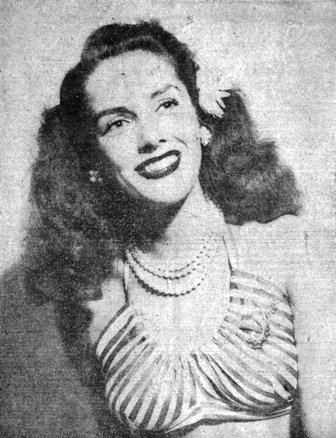 The lady up there is Miss Jinx Falkenberg, who, at the moment, is entertaining the personnel of the U.S. Army
in China. She is not only the Roundup's best gal, but, we are very much afraid, is going to wind up by
being the sweetie-pie of every G.I. in CBI. (Verse, not poetry.) The picture is good, but Eugenia in person is strictly something for the boys.
The lady up there is Miss Jinx Falkenberg, who, at the moment, is entertaining the personnel of the U.S. Army
in China. She is not only the Roundup's best gal, but, we are very much afraid, is going to wind up by
being the sweetie-pie of every G.I. in CBI. (Verse, not poetry.) The picture is good, but Eugenia in person is strictly something for the boys.
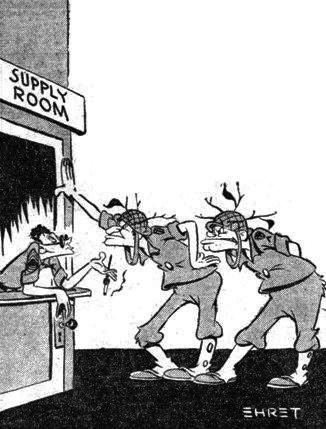
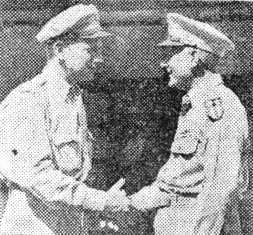
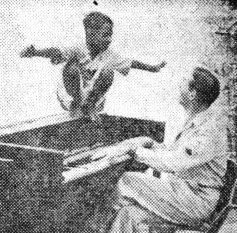 S/Sgt. Raymond Gray, entertainment director, is putting "Smoky," and Indian youngster, through an audition.
S/Sgt. Raymond Gray, entertainment director, is putting "Smoky," and Indian youngster, through an audition.
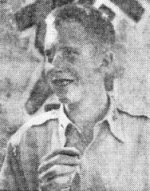 Capt. Peter S. Hopkins, the character who blew up the Jap's mountain.
Capt. Peter S. Hopkins, the character who blew up the Jap's mountain.
